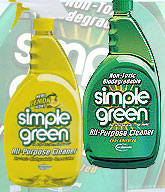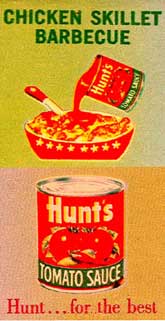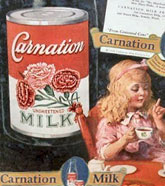|
Chemistry and Wilbur Scoville
It was in 1912 whilst working forthe Parke Davis pharmaceutical company that one of their chemists,
Wilbur Scoville, developed a method to measure the heat level of a chile pepper.
This test is named after him, it's called the Scoville Organoleptic Test,
and it's a dilution-taste procedure.
In the original test, Scoville blended pure ground chiles with a sugar-water solution and a panel of
testers then sipped the concoctions, in increasingly diluted concentrations,
until they reached the point at which the liquid no longer burned the mouth.
A number was then assigned to each chile based on how much it needed to be diluted
before you could taste no heat.
The pungency of chile peppers is measured in multiples of 100 units, from the bell
pepper at zero Scoville units to the incendiary Habanero at 300,000 Scoville
units!
One part of chile "heat" per 1,000,000 drops of water rates as only 1.5 Scoville Units.
The substance that makes a chile so hot (and therefore so enjoyable to Chile-Heads !),
is Capsaicin. Pure Capsaicin rates over 15,000,000 Scoville Units !
The "Red Savina" Habanero has been tested at over 577,000 Scoville units!
This is so much hotter than the normal Habanero chile pepper, that the "Guinness
Book of Records" has accepted it as "the hottest chile pepper" in the world.
Even now, breeders are attempting to beat this. The new Francisca Habanero is said
to be hotter still!
Stop Press
The new title holder, according to experts at the Defense Research Laboratory in the army garrison town of Tezpur in
the north-eastern state of Assam, is the local Naga Jolokia (capsicum frutescens).
It was nearly 50 per cent more pungent than the Red Savina Habanero from Mexico.
"Laboratory tests have confirmed that Naga Jolokia, a specialty from the north-east, is now the world's hottest
chilli," the laboratory's deputy director S.C. Das said by telephone from Tezpur.
The Naga Jolokia is grown mostly in the hilly terrain of north-east India and is a staple in every meal among
local tribals.
http://www.poole-associates.com/chilli.htm
PLEASE NOTE ... that there has been NO additional information about this variety. Chile-Heads around
the world suspect that it is only media hype and not real factual reporting......we wait and see!
Read further about the Naga Jolokia at:
The Daily Star Internet Edition @
http://www.dailystarnews.com/200009/06/n0090613.htm
SAfm Headlines @
http://www.safm.co.za/headlines/sep2000/head2_0609.html
India Abroad News Service @
http://news.indiainfo.com/2000/09/04/04chili.html
The validity and accuracy of the Scoville Organoleptic test have been widely
criticized. The American Spice Trade Association and the International Organization
for Standardization have adopted a modified version. The
American Society for Testing and Materials is considering other organoleptic
tests (the Gillett method) and a number of other chemical tests to assay for
capsaicinoids involved in pungency. Even so, the values obtained by these
various tests are often related back to Scoville Units. Nowadays the
High-Performance Liquid Chromatography (HPLC) test is used. In this
procedure, chile pods are dried, then ground. Next, the chemicals responsible for the pungency are extracted,
and the extract is injected into the HPLC for analysis. This method is more
costly than the previous, but it allows an objective heat analysis. Not only
does this method measure the total heat present, but it also allows the
amounts of the individual capsaicinoids to be determined. In addition, many
samples may be analyzed within a short period.
~~~~~~~~~ Capsaicin
As a result of all these tests, various varieties of chile peppers can be ranked according to their
heat or "pungency" level:
0-100
500-1000
1,000-1,500
1,000-2,000
1,000-2,500
2,500-5,000
5,000-15,000
15,000-30,000
30,000-50,000
50,000-100,000
100,000-350,000
200,000 to 300,000
Around 16,000,000
|
Scoville Units includes most Bell/Sweet pepper varieties.
Scoville Units includes New Mexican peppers.
Scoville Units includes Espanola peppers.
Scoville Units includes Ancho & Pasilla peppers.
Scoville Units includes Cascabel & Cherry peppers.
Scoville Units includes Jalapeno & Mirasol peppers.
Scoville Units includes Serrano peppers.
Scoville Units includes de Arbol peppers.
Scoville Units includes Cayenne & Tabasco peppers.
Scoville Units includes Chiltepin peppers
Scoville Units includes Scotch Bonnet & Thai peppers.
Scoville Units includes Habanero peppers.
Scoville Units is Pure Capsaicin.
|
|
3500-550,000
200-300,000
70-80,000
70-80,000
50-60,000
30-50,000
30-40,000
35-40,000
7-25,000
15-30,000
3.5-4,500
2.5-3,000
1-1,500
0
|
Red
Savina Habañero
Habañero
(Scotch Bonnet)
Thai
Chiltecpin
Santaka
Tabasco
Chilipiquin
Cayenne
Serrano
Chile
de Arbol
Jalapeno
Ancho
Poblano
Anaheim
Bell
Pepper |
http://www.calantilles.com/scoville.html
|
|
|
Here,
causing some of the "pain", is the chemical composition of the
better known of the Capsaicinoids (courtesy of John Henninge M.Sc.)

Capsaicin

Dihydrocapsaicin

Nordihydrocapsaicin

Homocapsaicin

Capsaicin, also known as N-Vanillyl-8-methyl-6-(E)-noneamide, is the most
pungent of the group of compounds called Capsaicinoids that can be isolated
from chile peppers. It is sparingly soluble in water, but very soluble in
fats, oils and alcohol. The minor Capsaicinoids include Nordihydrocapsaicin
[Dihydrocapsaicin with a (CH2)5 instead of (CH2)6], Homocapsaicin [Capsaicin
with a (CH2)5 instead of (CH2)4, and Homodihydrocapsaicin [Dihydrocapsaicin
with a (CH2)7 instead of (CH2)6].
Capsaicin and Dihydrocapsaicin together make up 80-90% of the Capsaicinoids
found in peppers. In the Capsicum annum species, the total Capsaicinoid content
ranges from 0.1 to 1.0%, and the Capsaicin to Dihydrocapsaicin ratio is about 1:1.
In Capsicum frutescens the total content ranges from 0.4-1.0% with the ratio
around 2:1.
Given all these various molecules, tests have shown that the Capsaicinoids can be
ranked according to their heat or "pungency" level:
At 8,600,000 Scoville Units is Homocapsaicin.
At 8,600,000 Scoville Units is Homodihydrocapsaicin.
At 9,100,000 Scoville Units is Nordihydrocapsaicin.
At 16,000,000 Scoville Units is Dihydrocapsaicin.
At 16,000,000 Scoville Units is Pure Capsaicin.
In order to douse the heat when eating chile peppers, try drinking milk or eating ice cream
or yoghourt. These dairy products are especially effective at breaking down the Capsaicin oils,
which are not soluble in water.
For more detailed chemistry of Capsaicin and other vanilloids, the Frostburg State
University has a very good web page with some useful links to other sites.
Dave DeWitt has written an interesting article titled 'The Nature of Capsaicin'.
The Brooklyn Botanic Garden has an interesting article by Paul Bosland on 'What makes Chile
Peppers hot?'
"The least irritating capsaicinoid is Nordihydrocapsaicin, according to researchers
at the University of Georgia. They found that the burning is located in the front of the
mouth and palate, causing a "mellow warming effect." The pungency sensation develops
immediately after swallowing and recedes rapidly.
In comparison, capsaicin and Dihydrocapsaicin were found to be more irritating, and were
described as having a "typical" pungency sensation. Both compounds produce pungency
in the middle of the mouth, the middle of the palate, the throat, and the back of the tongue.
In contrast, Homodihydrocapsaicin is very irritating, harsh, and very sharp. The pungency
does not develop immediately but it affects the throat, back of the tongue, and the palate for
a prolonged period."
Other compounds
A recent paper in Journal. Sci. Food Agric., 1995, 67, 189-196 by S.M. van
Ruth, J.P. Roozen and J.L. Cozijnsen, and available at The Department of
Chemistry, University of the West Indies, describes flavour components in
Bell peppers. Out of 47 compounds identified, 12 could be detected by
assessors at a sniffing port on a Gas Chromatograph:
3 (2220) 2-Methylpropanal
9 2-Methylbutanal
10 3-Methylbutanal
13 (2370) 2,3-Butanedione
15 (3382) 1-Penten-3-one
19 (2557) Hexanal
25 (2540) Heptanal
29 beta-Ocimene
35 trans-3-Hepten-2-one
39 Dimethyltrisulfide
45 (3132) 2-isobutyl-3-methoxypyrazine
47 (3639) beta-Cyclocitral
other compounds found in reasonable quantities were:
14 (3098) Pentanal
21 1-Methyl-1H-pyrrole
23 (3584) 1-Penten-3-ol
26 (2633) (R)-(+)-Limonene
36 cis-2-Heptenal
40 (2782) Nonanal
42 (2805) 1-Octen-3-ol
44 (2362) Decanal
The compound described as the character imparting compound in Bell peppers is
2-isobutyl-3-methoxypyrazine. This very powerful odorant has a threshold in
water of 1 part in 10^12.
Beer and water will only spread the flames !!
The following information is a guide to the process for the crude purification of Capsaicin that I found on the net.
Follow it at your own risk !
Ingredients:
15 Habanero peppers
1 quart 200 proof Ethanol
Method:
In a blender, puree the Habanero's in as much Ethanol as possible. Let the mixture
sit overnight at room temperature.
Pour the resultant sludge through paper towels and place the liquid in a glass
container. Begin to heat the liquid very slowly using either an electric heating
device (naked flames would be dangerous), or use a vapor trap to remove the alcohol
fumes safely.
Continue until 90% of the liquid has evaporated. Remove from the heat and let
cool. Look for a brick-red oil floating on the surface of the ethanol. If
none is present, continue to evaporate the ethanol away periodically cooling the
mixture to look for the red oil on the surface. Once the red oil appears, pour
the red oil and the remaining ethanol into a long thin glass cylinder, use an
eye dropper to suck off the oil and place it in a clean container. The red oil is
fairly pure Capsaicin, probably 40% Capsaicin / 60% Capsaicinoids.
Please bear in mind that Capsaicin is an extreme irritant and is hazardous to health as both
a chemical burn agent and as a poison when in its purer concentrated forms. Only a fool or
a chemist would want to undertake the above procedure
See Sigma-Aldrich publications for further information
Suggested reading and references
Govindarajan, VS and Sathyanarayana, MN; Capsicum - Production, Technology, Chemistry and Quality.
Part V. Impact on Physiology, Nutrition and Metabolism; Structure, Pungency, Pain and
Desensitisation Sequences, Crit. Rev. Food Sci. Nutr. 29, 435. 1991
"Peppers: History and Exploitation of a Serendipitous New Crop Discovery" by W. Hardy Eshbaugh, in New Crops, edited by Janick &
Simon, 1993.
New Mexico State University, Measuring Chile Pungency by Margaret Collins, Research Specialist and Paul W. Bosland, Prof. of Vegetable
Breeding and Genetics.
Many thanks to the Sunday Times for the review in the following article:
June 3 2001 DOORS
Feeling hot? Robbie Hudson is sweltering too
Testing is now carried out using liquid chromatography, as the helpful
http//:www.easyweb.easynet.co.uk/~gcaselton/chile/scoville.html explains. It also informs you that the hottest pepper is the
red savina (577,000), and reveals how to refine pure capsaicin (a terrifying 15m Scovilles). It adds that only a fool
would do this. Drinking aftersun lotion will not soothe any resultant burning.
http://easyweb.easynet.co.uk/~gcaselton/chile/scoville.html
|
























